- About
-
Research
- Agronomy and farming systems
-
Agricultural crop research
-
Research projects - agriculture
- About SASSA-SAI
- BioBoost
- Biomass Connect
- CTP for Sustainable Agricultural Innovation
- Climate Ready Beans - workshop presentations (March 2022)
- Crop diversity HPC cluster
- Designing Future Wheat
- Final project workshop
- Get involved
- List of materials
- News and updates
- Partners
- Rustwatch
- The Sentinel Crop Disease Surveillance Network
- The research team
- UK Cereal Pathogen Virulence Survey
- UK wheat varieties pedigree
- Weed management - IWM Praise
- Crop breeding
- Crop characterisation
- Data sciences
- Genetics and pre-breeding
- Plant biotechnology
- Plant pathology and entomology
- Resources
-
Research projects - agriculture
-
Horticultural crop research
-
Research projects - horticulture
- Augmented Berry Vision
- BEESPOKE
- Boosting brassica nutrition in smart growing systems
- CTP for Fruit Crop Research
- Develop user-friendly nutrient demand models
- Egg laying deterrents for spotted wing drosophila
- Enhancing the nutritional quality of tomatoes
- Improving berry harvest forecasts and productivity
- Improving vineyard soil health through groundcover management
- Intelligent growing systems
- Knowledge transfer for sustainable water use
- POME: Precision Orchard Management for Environment
- RASCAL
- STOP-SPOT
- UV-Robot
- Crop science and production systems
- Genetics, genomics and breeding
- Pest and pathogen ecology
- Field vegetables and salad crops
- Plum Demonstration Centre
- The WET Centre
- Viticulture and Oenology
-
Research projects - horticulture
- Crop Science Centre
- Research Projects
-
Services
- Analytical Services
- Business Development
- Commercial trial services
- Membership
- Plant breeding
- Plant characterisation
- Seed certification
-
Training
-
Technical agronomy training
- Advanced crop management of bulb onions
- Advanced crop management of vegetable brassicas
- Advanced nutrient management for combinable crops
- Benefits of cover crops in arable systems
- Best practice agronomy for cereals and oilseed rape
- Developing a Successful Strategy for Spring Crops
- Disease Management and Control in Cereal Crops
- Incorporating SFI options into your rotation
- Protected Environment Horticulture – Best Practice
- Techniques for better pest management in combinable crops
- Crop inspector and seed certification
- Licensed seed sampling
-
Technical agronomy training
- News & Views
- Events
-
Knowledge Hub
- Alternative and break crops
-
Crop genetics
- POSTER: Diversity enriched wheat (2025)
- POSTER: Genetics of wheat flag leaf size (2024)
- POSTER: Wheat yield stability (2024)
- Poster: Traits for future cereal crops (2022)
- POSTER: wild wheat fragment lines (2022)
- POSTER: Improving phenotyping in crop research (2022)
- PRESENTATION: Plant breeding for regen ag
- Poster: Designing Future Wheat (2020)
- Crop nutrition
-
Crop protection
- POSTER: Understanding the hierarchy of black-grass control (2025)
- POSTER: Emerging weed threats (2025)
- POSTER: Disease control in barley (2025)
- Poster: Weed seed predation in regen-ag (2024)
- POSTER: Disease control in winter wheat (2025)
- POSTER: Mode of action (2023)
- POSTER: Inter-row cultivation for black-grass control (2022)
- POSTER: UKCPVS winter wheat yellow rust in spring 2025 (2025)
- Poster: Management of Italian ryegrass (2021)
- POSTER: UKCPVS winter wheat rusts - 2024/25 review (2025)
- POSTER: UKCPVS disease monitoring and the benefit to UK growers (2025)
- POSTER: Diagnosing and scoring crop disease using AI (2025)
- POSTER: Finding new sources of Septoria resistance (2024)
- POSTER: Fungicide resistance research (2024)
- POSTER: Detecting air-borne pathogens (2024)
- POSTER: Oilseed rape diseases (2024)
- POSTER: Fungicide resistance research (2024)
- POSTER: Improving chocolate spot resistance (2022)
- Poster: Pathogen diagnostics (2022)
- Fruit
- Regen-ag & sustainability
-
Seed certification
- POSTER: Wheat DUS (2024)
- POSTER: Innovation in variety testing (2024)
- POSTER: AI and molecular markers for soft fruit (2024)
- POSTER: Barley crop identification (2023)
- POSTER: Herbage grass crop identification (2023)
- POSTER: Herbage legume crop identification (2024)
- POSTER: Minor cereal crop inspecting (2023)
- POSTER: Pulse crop identification (2023)
- POSTER: Wheat crop identification (2023)
-
Soils and farming systems
- POSTER: Checking soil health - across space and time (2024)
- POSTER: Checking soil health - step by step (2024)
- POSTERS: Changing soil management practices (2022)
- Poster: Monitoring natural enemies & pollinators (2021)
- POSTER: Soil structure and organic matter (2024)
- POSTER: Novel wheat genotypes for regen-ag (2024)
- Video: New Farming Systems project (2021)
- Video: Saxmundham Experimental Site (2021)
- POSTER: Impact of prolonged rainfall on soil structure (2024)
- POSTER: Soil & agronomic monitoring study (2024)
- POSTER: The impact of rotations & cultivations (2024)
- VIDEO: Great Soils; soil sampling guidelines (2020)
- Poster: Soil invertebrates within arable rotations (2024)
- VIDEO: Soil health assessment (2021)
- POSTER: Saxmundham - modern P management learnings
- POSTER: Saxmundham - 125 years of phosphorus management
- Poster: Soil phosphorus - availability, uptake and management (2025)
- POSTER: Morley long term experiments (2025)
- POSTER: Exploiting novel wheat genotypes for regen-ag (2025)
- Video: Saxmundham Experimental Site (2021)
- Varieties
Disorders of the flesh
Disorders occurring naturally during storage
Senescent breakdown
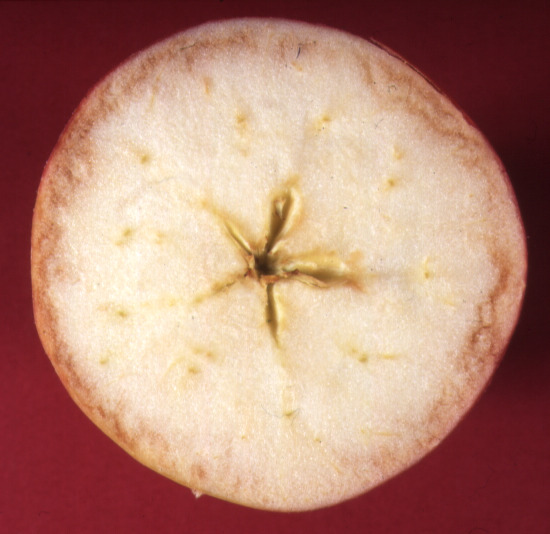
Senescent breakdown (Gala)
- This disorder is usually associated with over-maturity or over-storage and is accentuated by mineral imbalance in the fruit at harvest and particularly with inadequate calcium.
- Compliance with suggested mineral standards, harvesting at the correct stage of maturity, maintaining the correct storage conditions for the periods advised and prompt marketing of fruit after storage should avoid the problem.
- It is particularly difficult to distinguish different forms of breakdown on the basis of visual symptoms. The appearance varies between cultivars, and storage conditions have a major influence on expression of symptoms.
- Typically in air-stored Cox and Bramley apples (and sometimes in CA-stored fruit) senescent breakdown appears on the outside as a dull darkening of the skin that progresses inwards.
- However, in CA-stored fruit there may be a gradual discoloration of the flesh that can be confused with low temperature breakdown.
- In Gala apples (see figure) senescent breakdown generally affects the layers of tissue immediately below the skin and spreads around the fruit before progressing inwards.
- More recently, a breakdown associated with the stalk end (stem bowl) of Gala fruit has been observed. Similar symptoms have been reported in Gala grown in the USA. Splitting of the skin around the stalk has been reported in some European countries. Earlier investigations on stem-end splitting in Gala cracking in Washington State (Andrews 2001) found the disorder was associated with over maturity and that the tissue around the stem bowl matures earlier than tissue near the equator, so conventional starch tests of equatorial slices may not pick up excessively mature tissue in the stem bowl region. Therefore staining longitudinal cut fruit with iodine and additional cross sections at the shoulder end of the fruit, may identify orchard consignments where excessive stalk end maturity has occurred at the point of harvest.
- The shape and structure of cells in the stem region are orientated longitudinally and are more elongated in appearance than cells of tissue around the equator which may explain why tissue is more prone to cracking and general cell separation leading to excessive softening. Reducing spring nitrogen application as well as increasing fruit calcium content were considered factors that might help reduce stem-end stroage disorders (Andrews 2001).
Low temperature breakdown
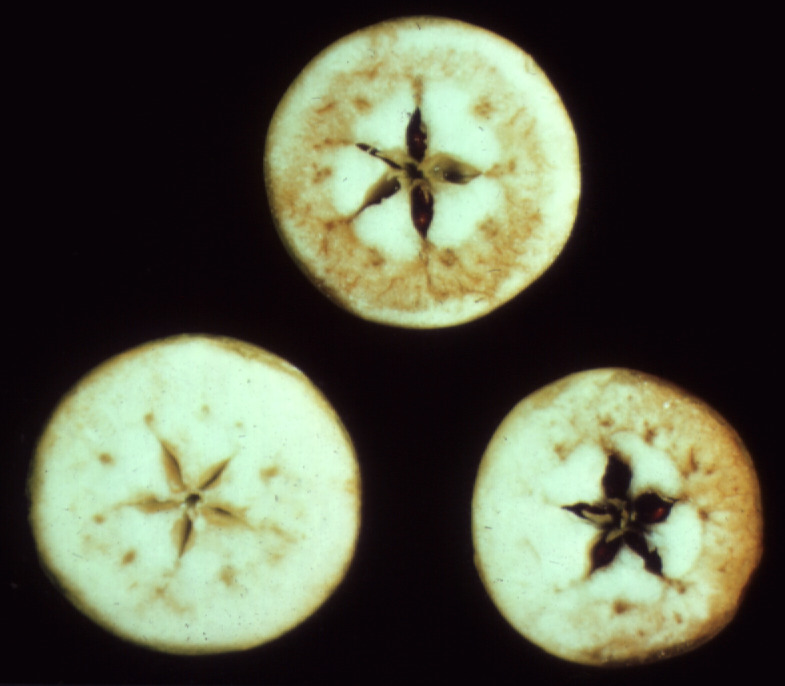 |
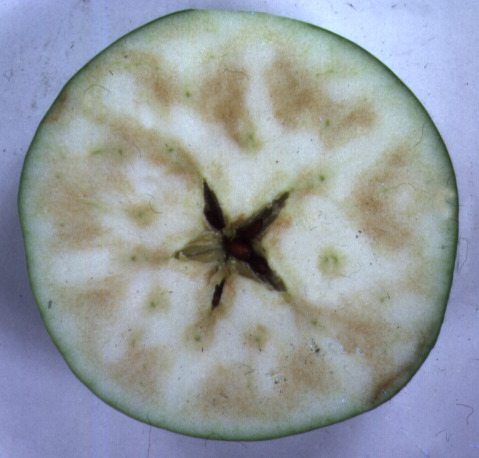 |
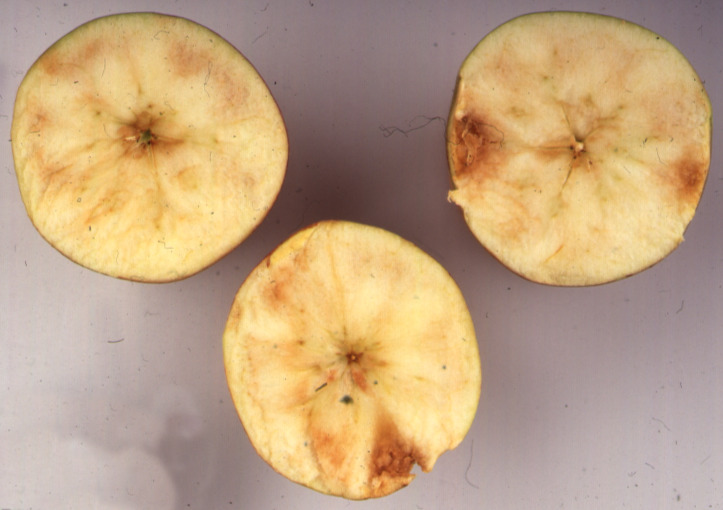 |
| Low temperature breakdown (air stored Cox) | Low temperature breakdown (Bramley) | Low temperature breakdown (CA stored Cox) |
- As with senescent breakdown the symptoms of low temperature breakdown (LTB) vary according to storage conditions and it is often difficult to be certain about the type of breakdown where the apple flesh is affected by a general browning.
- In air-stored Cox and Bramley apples areas of the cortical tissue affected by LTB appear similar to senescent breakdown.
- However, in LTB-affected apples there is normally a zone of healthy tissue immediately below the skin and the cut surface of affected tissue is usually moist when compared with senescent breakdown.
- LTB normally develops before fruits become overripe.
- Fruit kept in CA are more susceptible to LTB than those kept in air storage. Consequently higher storage temperatures and usually recommended for CA than for air storage (see section on Optimal storage conditions).
- LTB symptoms in CA-stored fruit are different to those in air-stored fruit and take the form of a general browning of the cortical tissue and often there is a wedge-shaped pattern in the apple cortex. This is apparent particularly in Bramley but less so in Cox.
- LTB is a product of two factors, namely temperature and time of exposure.
- Short periods of exposure to low temperatures will not cause LTB.
- The disorder can occur at recommended storage temperatures.
- Cool growing seasons and late picking increase the susceptibility of Cox and Bramley apples to LTB. Prediction of LTB risk is possible based on climatic conditions during the growing season and mineral composition of the fruit at harvest.
- The disorder is progressive in store and may progress significantly in apples removed to ambient conditions.
- Immediate marketing is recommended when LTB is present in samples removed during store monitoring.
Water core breakdown
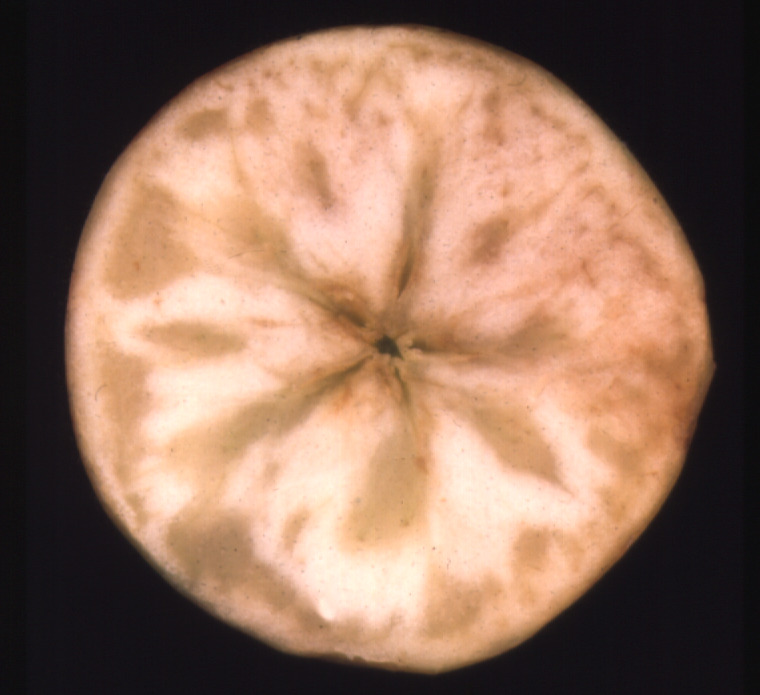
Water core breakdown
- As the name implies, water core breakdown is a flesh breakdown that develops in fruit affected by water core at harvest.
- The disorder is not common in apple cultivars grown in the UK since water core is not usually problematic (see water core below).
Diffuse browning disorder
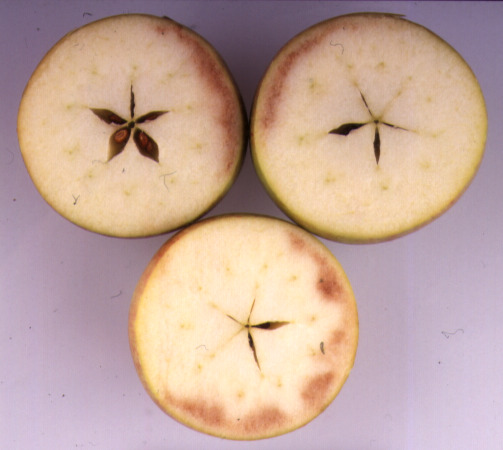
Diffuse browning disorder (Cox)
- Referred to colloquially as ‘boggy bank disorder’ after the first reported occurrence in a Cox orchard of that name.
- Prior to 2000 there were few cases of diffuse browning disorder (DBD) causing significant problems in commercial fruit. However, the disorder has caused severe problems in some consignments of Cox apples since 2000.
- The disorder first appears as a localised browning of the flesh predominantly towards the calyx end of the fruit.
- The disorder progresses around the fruit and may progress to the inner cortex.
- Often there is a healthy band of tissue beneath the skin of the fruit so it is difficult to detect affected fruit from an external examination.
- Research done at NIAB EMR established a link between the application of orchard sprays containing triazole chemicals and the development of DBD in CA-stored fruit (Johnson, 2007; 2008a).
- Triazoles are compounds with a composition of C2H3N3 having a 5-membered ring of 2 carbon atoms and 3 nitrogen atoms and include the commonly applied fungicide penconazole (Topas and Topenco).
- In grower trials fungicide application was more conducive to DBD development than application of paclobutrazol (a triazole containing growth regulator which used to be approved for use on apples) but in combination induced the highest level of DBD.
- In these studies some orchards did not produce susceptible fruit despite application of triazole chemical sprays.
- Clearly other unknown factors determine whether the chemical stress exerted by the use of triazoles results in the development of clinical symptoms in stored fruit.
- In HDC-funded research carried out by FAST Ltd (HDC project TF 166f), sprays of the previously approved triazole fungicide myclobutanil (Systhane) induced slightly more DBD than the previously approved triazole containing growth regulator paclobutrazol (Cultar) but by far the greatest inducement of DBD occurred following application of the triazole containing fungicide penconazole (Topas or Topenco).
- DBD in CA-stored fruit increased with increased number of application of triazole chemicals and late applications appeared particularly conducive to DBD development.
- DBD development cannot be ameliorated by modification of storage conditions and conversely storage at lower than recommended temperatures was found to aggravate the problem.
- There appears to be no influence of fruit mineral composition on DBD susceptibility and no influence of post-harvest treatments such as SmartFreshTM or delayed cooling (Johnson, 2006; 2008a; 2008b).
- There should be rigorous monitoring of fruit in store and detection of the disorder should invoke immediate marketing.
Action points for growers
- Growers should discuss with their advisers the potential impact of agrochemicals on DBD susceptibility for their particular circumstances.
- Non-triazole fungicides should be used in preference to triazole-based fungicides.
- Where disease control is a priority the most appropriate spray regime may include triazole fungicides. In such cases the duration of storage may be curtailed in order to avoid problems with DBD.
- Reduction or avoidance of triazole chemicals in spray programmes should be regarded as an interim measure until further work has been done on the effect of specific chemicals and on the frequency and timing of spray applications.
Disorders induced by CA conditions
Internal carbon dioxide injury ('brownheart')
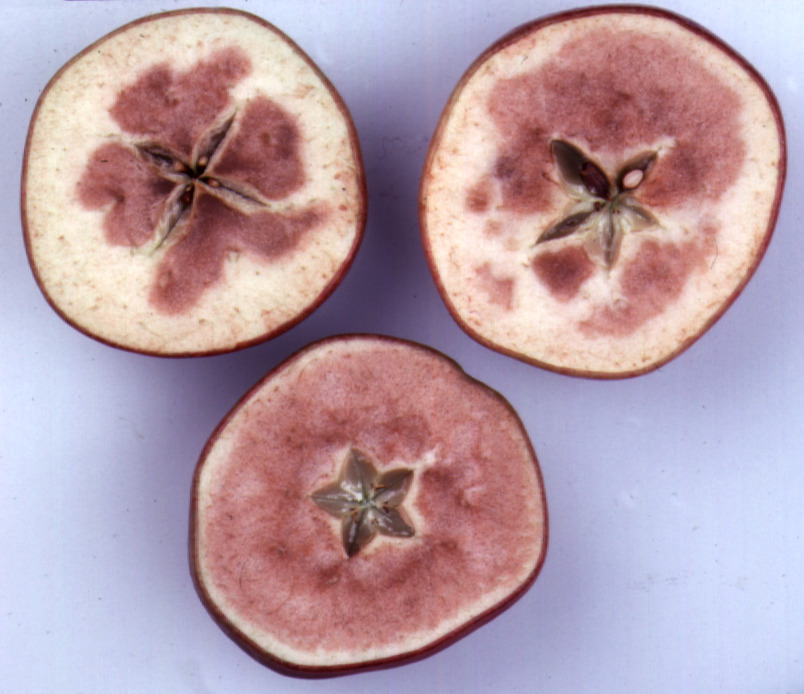
Internal carbon dioxide injury
- As the name implies internal carbon dioxide injury is normally associated with abnormally high concentrations of carbon dioxide in the storage atmosphere.
- Adherence to storage recommendations that are provided for different cultivars of apple should avoid the problem.
- Bramley’s Seedling apples stored in 5% CO2 + 1% O2 (5/1) are susceptible to brownheart and it is necessary to delay establishment of CA conditions until 10 days after loading is complete.
- Where SmartFreshTM is used prior to 5/1 storage the delay should be extended to 21 days.
- An alternative regime establishment protocol has been tested whereby O2 levels are allowed to drop by fruit respiration to 10%, keeping CO2 scrubbed to <1.0%CO2. After the 21 day period has passed, CO2 is allowed to rise to 5% while O2 drops via respiration.
- Similarly it is important to ensure that carbon dioxide concentrations are 1% or less when low oxygen conditions (1.2% O2) are first established in Cox stores.
- It is important to operate Cox stores at 2% O2 for at least a week prior to lowering to 1 or 1.2% O2 in order to reduce respiration rate (and CO2 concentration inside the fruit).
- Carbon dioxide injury often begins in the vascular tissue and then extends to include large areas of the cortical tissue.
- Injured areas have a moist, rubbery texture at first but eventually the injured tissue dries out and ‘cork-like’ cavities appear.
Core flush
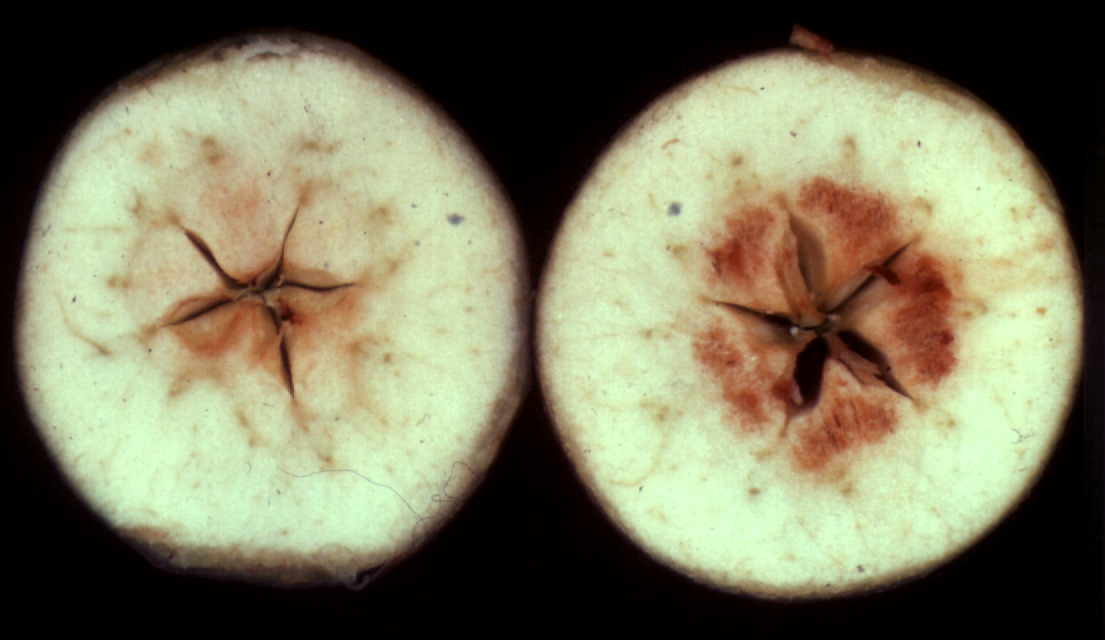
Core flush
- Core flush is a pink or brown discoloration of the core of apples.
- It occurs late in the storage period and is aggravated by increased carbon dioxide in the storage atmosphere and by lower storage temperatures.
- Cultivars vary in their susceptibility to the disorder. In the UK Cox’s Orange Pippin, Bramley’s Seedling and Braeburn are regarded as highly susceptible although application of best practice as regards the use of appropriate storage conditions, avoidance of over-storage and prompt marketing of fruit after storage generally ensure that core flush is not a commercial problem.
- Storage of Cox apples in the virtual absence of carbon dioxide, and in low oxygen conditions provides good control of the disorder.
- Generally core flush is aggravated by early harvesting, unduly high water loss in store and cool summer temperatures.
- The use of SmartFreshTM aggravates core flush in some cultivars of apple. Core flush development limits the storage life of SmartFreshTM-treated Cox stored in CA and excludes the use of SmartFreshTM on Braeburn.
- Dynamic controlled atmosphere (DCA) storage has been shown to be a useful technique to lower the incidence of internal disorders such as core-flush in Braeburn. More work is required to fully ascertain the benefit. DCA has not been tested widely on Cox.
Disorders induced by mineral deficiencies pre-harvest
Bitter pit
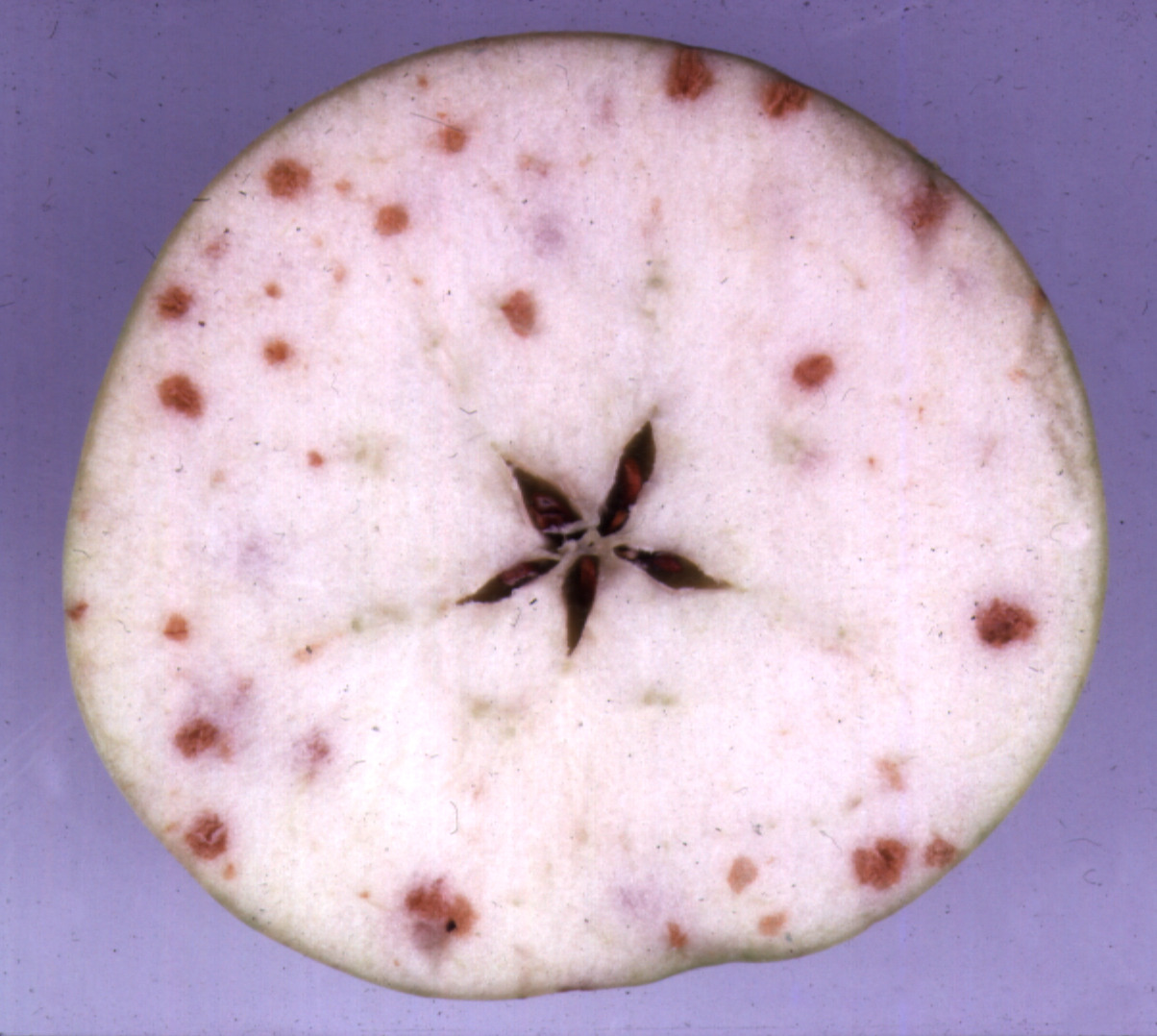
Bitter pit (Bramley)
- Bitter pit is probably the disorder that is most familiar to apple growers, both in the UK and abroad, and is of major economic importance.
- Symptoms appear as roughly spherical brown lesions in the flesh of the fruit.
- The ‘pits’ are dry in appearance and occur mostly just below the skin but in severe cases may affect the entire cortex.
- Bitter pit susceptibility is linked with critical levels of calcium in the tissue and the more frequent occurrence at the calyx end of the fruit relates to the low calcium status of this region.
- Although symptoms of bitter pit may be seen on the tree generally the disorder develops progressively in store.
- Early picking and excessive tree pruning can lead to a higher incidence of bitter pit.
- Consignments of fruit with inadequate calcium as evidenced by fruit analysis should be sold immediately or stored for short periods.
- Orchards should be managed in a way that ensures adequate calcium uptake and retention by the developing fruit.
- It is important to avoid irregular and excessive vegetative growth.
- Heavy use of potassium and nitrogen fertiliser should be avoided and a comprehensive programme of calcium sprays is recommended for susceptible cultivars.
- Under UK conditions Bramley’s Seedling, Cox’s Orange Pippin and Egremont Russet are particularly susceptible to bitter pit.
- Meridian and Red Pippin are also susceptible whereas the disorder is rarely seen in Braeburn and Jonagold and has not been reported in Gala.
- Although bitter pit is essentially an orchard condition the development of symptoms after harvest is influenced markedly by the conditions under which the fruit is stored.
- Prompt cooling, lower storage temperatures and more stringent CA conditions retard bitter pit development and may be partly curative.
- These effects are taken into account when setting mineral analysis standards.
- Molecular diagnostic tests are currently being developed (NSURE) to predict the likelihood of orchard consignments developing bitter pit.
Late storage corking
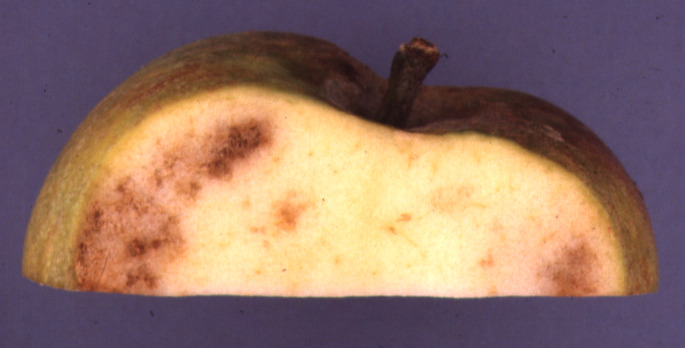
Late storage corking
- This disorder of Cox apples is usually apparent only after 6 months storage in 1.2% oxygen.
- The lesions are ‘corky’ in appearance and have similarities with bitter pit.
- However, late storage corking is more extensive and, unlike bitter pit, occurs predominantly in the region between the stem-end and the equator of the fruit.
- The disorder is progressive in storage and may increase significantly during distribution and marketing particularly at ambient temperatures.
- Emphasis for prevention of the disorder is placed on pre-harvest factors.
- An imbalance of potassium to calcium in the fruit at harvest has proved to be of major importance. Consequently, fruit for long-term storage in 1.2 % oxygen should contain more than 5 mg 100g-1 of calcium and less than 150 mg 100g-1 of potassium.
Water core
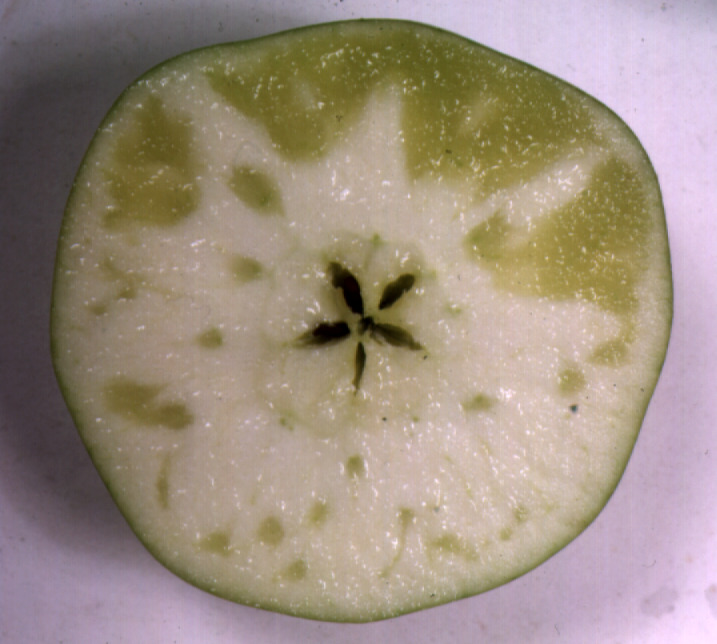
Water core (Bramley)
- Water core occurs in fruit on the tree and therefore is not strictly a storage disorder.
- It usually becomes less severe during storage and symptoms may disappear entirely.
- However, water core symptoms may be present in fruit removed from store at which time water core breakdown may also be present (see above – water core breakdown).
- Water core is described as a ‘glassy’ appearance of the apple flesh caused by the presence of sap in the intercellular spaces.
- Analysis of apples affected by water core showed that concentrations of calcium were very low (<4 mg 100g-1) and therefore occurrences of this disorder in the orchard indicate that other calcium-dependent disorders, such as bitter pit and senescent breakdown, are likely to develop during storage.
- Control measures for water core are similar to those described for bitter pit (see above).
Internal corking
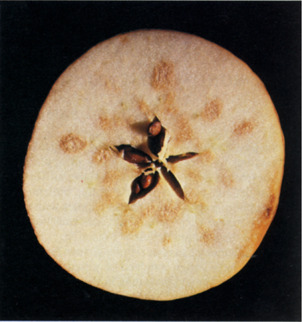
Internal corking (boron deficiency)
- Internal corking disorders of apple may have some similarities with bitter pit but are associated with boron deficiency.
- Internal cork always affects the core area, and in seriously affected fruit, part or most of the flesh will be affected.
- When the flesh is affected brown, corky, diffuse streaks or wedge-like areas extend from the core into the flesh.
- Although it has been stated that boron deficiency symptoms are unknown in apples grown in the UK it is probably more.
Disorders induced by orchard and storage factors
Braeburn browning disorder (BBD)
- Braeburn is susceptible to developing internal browning disorders of the cortex known as Braeburn browning disorder (BBD) and formation of internal cavities in the flesh similar to internal CO2-injury.
- The incidence and severity of the disorder is dependent on orchard and storage factors.
- Apples with higher fruit densities from un-thinned trees can display increased severity of the disorder.
- Late picking of fruit will increase the risk due to increased respiration and skin resistance to gas exchange.
- Cool seasons can lead to increased risk of BBD due to increased fruit density and higher resistance to gas diffusion.
- Keeping CO2 levels in store to their lowest concentrations (<1.0% and preferably to <0.6%) will help reduce the incidence of BBD.
- BBD is less of a problem in air-stored fruit.
- Dynamic controlled atmosphere (DCA) storage has been shown to reduce internal browning and core flush in Braeburn.





